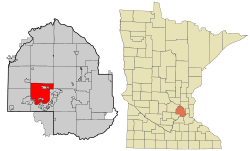Orono, Minnesota facts for kids
Quick facts for kids
Orono
|
|
|---|---|
| Motto(s):
"The Lakeshore City"
|
|

Location of Orono
within Hennepin County, Minnesota |
|
| Country | United States |
| State | Minnesota |
| County | Hennepin |
| Founded | 1889 |
| Incorporated | 1955 |
| Area | |
| • Total | 23.98 sq mi (62.12 km2) |
| • Land | 15.92 sq mi (41.22 km2) |
| • Water | 8.07 sq mi (20.90 km2) |
| Elevation | 935 ft (296 m) |
| Population
(2020)
|
|
| • Total | 8,315 |
| • Density | 522.40/sq mi (201.70/km2) |
| Time zone | UTC-6 (Central (CST)) |
| • Summer (DST) | UTC-5 (CDT) |
| ZIP codes |
55300, 55391, 55399, 55356
|
| Area code(s) | 952 |
| FIPS code | 27-48580 |
| GNIS feature ID | 0648996 |
| Website | www.ci.orono.mn.us |
Orono (pronounced ORR-ə-noh) is a city in Hennepin County, Minnesota, United States. It is located west of Minneapolis on the north shore of Lake Minnetonka. Orono is known as one of the wealthiest cities in Minnesota.
In 2020, the city had a population of 8,315 people. Orono is part of the larger Minneapolis-Saint Paul metropolitan area.
Contents
History of Orono
How Orono Was Formed
Orono was first part of Excelsior Township. Later, in 1868, it became part of Medina Township. In 1889, the people living in Orono got permission to form their own independent town.
Orono officially became a city in 1955. The city was named after Orono, Maine. This was the hometown of an early resident named George A. Brackett.
Fire Service in Orono
The city of Orono has been working to create its own fire department. Before this, the Long Lake Fire Department provided fire services to Orono. The city has been taking steps to build its own fire service, including hiring a fire chief and buying equipment.
Geography of Orono
Orono is a city with a lot of natural beauty. It covers about 25.15 square miles (65.14 square kilometers). A large part of this area is water, about 9.17 square miles (23.75 square kilometers). This water area includes parts of Lake Minnetonka.
The land area of Orono is about 15.98 square miles (41.39 square kilometers). U.S. Highway 12 is a major road that runs through the city.
Population and People of Orono
| Historical population | |||
|---|---|---|---|
| Census | Pop. | %± | |
| 1890 | 872 | — | |
| 1900 | 1,086 | 24.5% | |
| 1910 | 1,311 | 20.7% | |
| 1920 | 1,159 | −11.6% | |
| 1930 | 1,795 | 54.9% | |
| 1940 | 2,780 | 54.9% | |
| 1950 | 4,863 | 74.9% | |
| 1960 | 5,643 | 16.0% | |
| 1970 | 6,787 | 20.3% | |
| 1980 | 6,845 | 0.9% | |
| 1990 | 7,285 | 6.4% | |
| 2000 | 7,538 | 3.5% | |
| 2010 | 7,437 | −1.3% | |
| 2020 | 8,315 | 11.8% | |
| U.S. Decennial Census | |||
Orono's Population in 2010
Based on the census from 2010, Orono had 7,437 people living there. There were 2,826 households, which are groups of people living together in one home. Most of these (2,155) were families.
The city had about 465 people per square mile (179 people per square kilometer). Most residents, about 96.5%, identified as White. Other groups included African American, Native American, and Asian people. About 1.7% of the population was Hispanic or Latino.
Households and Age in Orono
In 2010, about 35.2% of households had children under 18 years old. Most households (67.7%) were married couples living together. The average household had 2.63 people, and the average family had 3.02 people.
The median age in Orono was 45.7 years old. About 26.6% of the residents were under 18. About 12.6% were 65 years old or older. The population was almost evenly split between males (51.2%) and females (48.8%).
Notable People from Orono
Many interesting people have lived in Orono. Here are a few:
- George A. Brackett - An early Minnesota businessman and politician.
- Carlos Correa - A famous baseball player for the Minnesota Twins.
- Bruce Dayton - A business leader who was in charge of the Target Corporation. He also started B. Dalton bookstores.
- Mark Dayton - A former senator and governor of Minnesota.
- William Hood Dunwoody - Had a summer home on Brackett's Point.
- Kevin Garnett - A well-known National Basketball Association (NBA) player.
- James J. Hill - Known as "The Empire Builder," he had a farm nearby. He also gave the Hill School to the community.
- Irwin L. Jacobs - A businessman and entrepreneur.
- Greg LeMond - A famous racing cyclist.
- Whitney MacMillan - A billionaire and former head of Cargill, a large food company.
- William W. McGuire - Former head of UnitedHealth Group and owner of the Minnesota United FC soccer team.
- Charles Pillsbury - A former resident.
- George S. Pillsbury - An American businessman and politician.
- Robert L. Searles - A businessman, Minnesota state representative, and former mayor of Orono.
- Gregg Steinhafel - The former president and CEO of Target Corporation.
See also
 In Spanish: Orono (Minnesota) para niños
In Spanish: Orono (Minnesota) para niños

